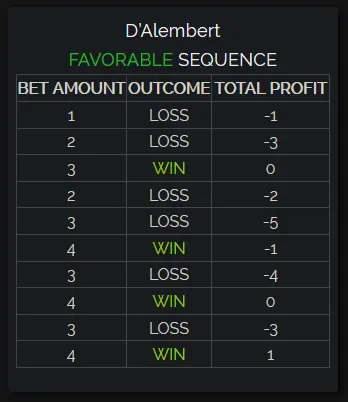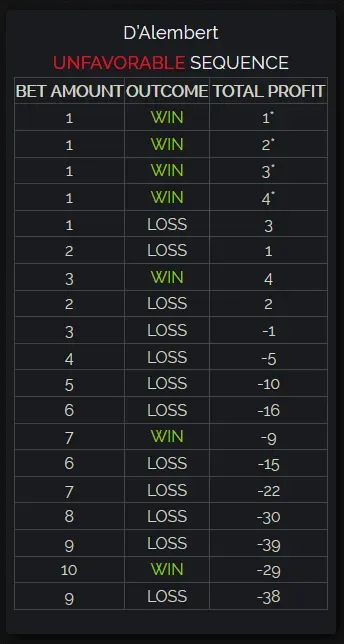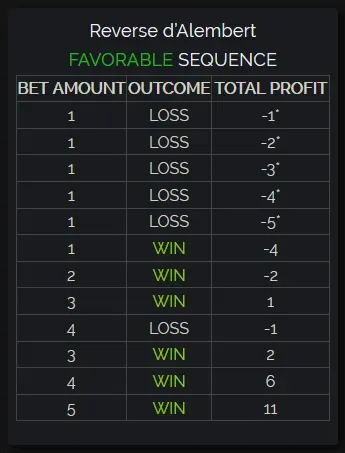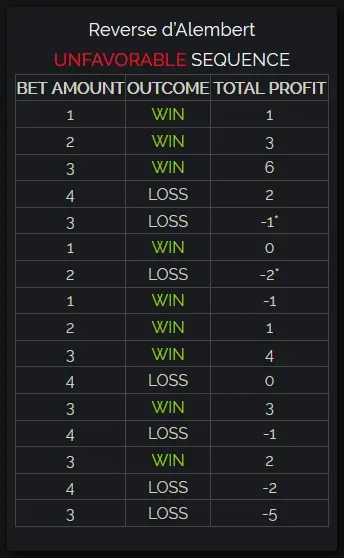The mathematician
D’Alembert system
Examples
Reverse d’Alembert explained
Examples
Variations and comments
A great mathematician defends the gambler’s fallacy
Jean-Baptiste le Rond d’Alembert (17 November 1717 – 29 October 1783) was a great mathematician who contributed to the ‘foundations of mathematics’. furthermore,r he was a philosopher and music theoretician and among the most influential men of his time as the co-editor with Denis Diderot of the famous Encyclopédie.
He was well known for his opinions contrary to the scientific theories of his time. His “errors” and paradoxes abound in 18th-century mathematical literature. He believed that the result of tossing three coins differs from three tosses of one coin. He also believed that Tails are more probable after a long run of Heads, and promulgated the doctrine that a very small probability is practically equivalent to zero. This idea leads to the progression betting system that bears his name. His analyses of card and dice games were equally penetrating.
Jean d’Alembert was a fanatical proponent of what we call today the “gambler’s fallacy” and this system bears his name and is based on his ideas.
D’Alembert betting system
The d’Alebert betting system or “simple progression” is a linear betting system for the Even Chances (or Simple Chances) of roulette: Red, Black, Odd, Even, High and Low. Linear betting systems involve a fixed additive constant and can be defined by the following rules:

How to play the d’Alembert roulette system?
Bet on your favorite color (Red or Black) by following these simple rules:
- The first bet is one unit (1 chip).
- When we lose we increase our bet by one unit.
- When we win we decrease our bet by one unit.
- When we achieve a net profit, we reset the progression and start over with one unit.
In simple terms the progression can be described by this series of numbers:
1-2-3-4-5-6-7-8-9-10-11 etc.
The idea is that when the losses increase in number then it is worth betting more, because the expectation of a win increases accordingly. And what we try to achieve is to be payed for our wins more than we paid for our losses.
The d’Alembert is a very easy method to play even for a newbie; not complicated calculations needed, as is the case for Labouchere for example. Just increase as you lose, decrease as you win; until profit. It is also a much less aggressive system than Martingale, because instead of doubling our bets for each loss we only increase them by 1 unit. Therefore a long series of losses will not destroy all our bankroll, which is the case with Martingale. On the other hand it usually requires much more than just one win to recoup our losses.
Generally speaking, we need a “2 wins for 3 losses” or “2 wins per 5 spins” win ratio in order for the d’Alembert to produce a profit. And this ration gets slightly worse as the number of spins increase. For example, after 3 losses we need only 2 wins to reach a profit (-1-2-3+4+3 =1 unit profit). This is a 2 wins per 5 spins ratio. After 100 losses one will need 87 wins to make a profit, which is a 2,2 wins per 5 spins ratio.
A favorable spin sequence for the d’Alembert is one with many breaks (choppy sequence) where wins alternate with losses very often. In such sequences, the system shows the benefit of winning with one unit more than the previous loss. The less favorable scenarios involve either many first spin wins, in which case we only win one unit per hit, followed often by a really bad streak in which case the d’Alembert has not the power to recoup our losses fast. enough.
Examples

This was a simple and nice sequence. With 6 losses and 4 wins we managed to win 1 unit. If we used flat betting we would be losing 2 units.
In the following example after 7 wins and 12 losses we are 38 chips in the hole and our bets are quite high at 10 units per spin. A simple Martingale would have fared much better. Now we see very clearly the main disadvantages of the d’Alembert progression:
- It can not take good advantage of continuous first spin wins. It resets to 1 unit after we reach profit and we only earn 1 unit per win.
- It has not the power of Martingale for example, to recoup losses and make a profit from an unfavorable spin sequence with just a few wins.

In order to overcome the disadvantage of winning only one unit with continuous wins at roulette, there is a variation of d’Alembert in which we begin our betting with 5 units. If we win immediately, then we take the profit and next time we start with 4 units. And if we win again we start next with 3 units etc. The disadvantage of this nice trick is that it is a bit more high risk, because our progression starts with 5 units and a bad run can lead to high bets faster than the original system.
Reverse d’Alembert (contra d’Alembert) explained
How to play the reverse d’Alembert system?
Just follow these simple rules:
- We decide on a profit target – for example, 10 units profit.
- Our first bet is one unit (1 chip).
- When we win we increase our bet by one unit (chip).
- When we lose we decrease our bet by one unit.
- When we reach a net loss or our predefined profit target, we reset the progression and start over with one unit.
Obviously, reverse d’Alembert is based on the contrary idea than the original. The intention is to increase our bets as we win in order to take advantage of good streaks, like in the Parlay system. We reset after each first spin loss and when we start winning we keep betting until we lose all our profit or until we reach a predetermined profit.
Examples
Let’s say that our predetermined win target is 10 chips. Let’s see two very different spin sequences that will illustrate the strength and weakness of reverse d’Alembert.
In the following sequence of 6 wins and 6 losses, we manage to reach our profit target of 10 units. This system takes great advantage of streaks of losses and wins.

Now it is time for the bad news. In this amazing sequence with 9 wins and only 7 losses we “managed” to loose 5 units. As it is expected, the many breaks (alternating wins and losses) that are very favorable to the classic d’Alembert are disastrous for the Contra d’Alembert.

Variations and comments
My friend Reyth has experimented extensively with this progression and has developed various systems for dozens/columns and streets based on d’Alembert:
- Double Dozen D’Alembert
- “Simple street” D’Alembert strategy for street bets.
- D’Alembert Avenue System
Here is what he has to say:
The D’Alembert progression is genius. I haven’t found a method more able to quickly and easily amass profits due to its natural ability to bet smaller during successive losses and larger with wins after those successive losses.
Unfortunately, this system in its elementary form is still vulnerable to successive losses that will eclipse virtually every bankroll.
Somehow a middle ground must be struck that allows for the majority of substantial wins to be gained so that the losses that must be accepted are less than those wins. This will require further genius which I feel quite incapable of at this time.
Conclusion
Although a very basic and easy to play system I can not advise the d’Alembert to a new player. Its 2 wins for 3 losses may sound tempting, but it is very easy to face a bad sequence that will increase your losses and your bets. In fact, I think that the Reverse d’Alembert is a more appropriate method for a new player, because one can have better control of his losses.